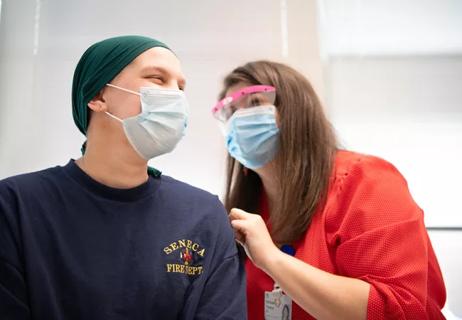Recommendations reflect weak evidence, unnecessary risks or high costs

A new report authored by over a dozen pediatric hematologists at centers across the U.S. raises questions about the role of five hematologic tests and treatments in clinical practice.
Cleveland Clinic is a non-profit academic medical center. Advertising on our site helps support our mission. We do not endorse non-Cleveland Clinic products or services. Policy
As part of the Choosing Wisely® Campaign, an initiative led by the American Board of Internal Medicine Foundation, participating medical societies are tasked with identifying five tests or procedures that warrant deliberation about their utility.
The American Society of Pediatric Hematology/Oncology and the American Society of Hematology formed a task force in 2019, initiating a review process that led to these specific recommendations.
Seth Rotz, MD, pediatric hematologist-oncologist at Cleveland Clinic Children’s and one of the paper’s authors, says the recommendations reflect guidance on practices that are either not supported by robust evidence, are associated with unnecessary risks, high costs, or are not clinically meaningful.
Dr. Rotz discusses these considerations below.
“When a child is undergoing a routine procedure with no indications for a bleeding disorder, we discourage the use of hematologic testing,” he says. “The chance of diagnosing a bleeding disorder in this setting, in a patient with no prior history or family history, is exceedingly rare.” He goes on to say that false-positive tests lead to more blood draws, creating unnecessary anxiety and delays for patients and families.
“There’s no evidence that suggests obtaining these blood tests preoperatively prevents bleeding complications during surgery,” he says. “Instead, a careful history of any abnormal bruising or bleeding in the patient or family is much more important.”
There is a common misconception that a drop in platelet count warrants an immediate transfusion in children with bone marrow failure or malignancy, but that’s simply not the case, asserts Dr. Rotz.
“The only evidence that supports prophylactic platelet transfusion below a very low threshold in children with hypoproliferative thrombocytopenia is if the child is bleeding or is about to undergo an invasive procedure,” he explains.
While transfusions are largely well-tolerated in this patient population, multiple transfusions mean increased exposure to the risk of allo-immunization or other infusion reactions — not to mention the importance of economic stewardship of platelets, a costly and vital resource.
Venous thromboembolism, while rare in children, is not entirely uncommon in children hospitalized for chronic conditions and with a venous catheter. However, in the absence of family history, testing for inherited thrombophilia is rarely warranted.
Further, there is a significant financial cost associated with testing for inherited thrombophilia, and the psychological implications of a misinterpretation of risk should not be overlooked, he notes.
The task force does acknowledge, however, that consensus of the definition of a “positive family history” is needed to improve the overall management of patients with venous thromboembolism.
This recommendation calls for prudence in administering a packed red blood cell transfusion in children with iron deficiency anemia (IDA) and no active bleeding or symptoms. IDA is most commonly managed through iron replacement therapy via oral or intravenous intake or interventions that target underlying etiology.
“In children with chronic iron deficiency and no other symptoms, even if their hemoglobin is quite low, there is usually no need for a red blood cell transfusion,” says Dr. Rotz.
Packed red blood cells alone aren’t therapeutic for IDA, the authors report. And physicians must also consider the potential medical risks and financial costs associated with this procedure.
It’s well-documented that the routine use of G-CSF, a hormone that stimulates white blood cell growth, is not effective in the management of children with asymptomatic AIN.
The majority of children with AIN are slightly more likely to experience upper respiratory infections and may be more likely to experience gingivitis. Although rare, some severe cases have been reported in infants, but routine use of G-CSF in otherwise asymptotic patients is not warranted.
“Again, there is a tendency to want to treat a low blood cell count to quickly normalize numbers, but in the absence of severe infection, there is no need to put the child through such a regimen to do so,” says Dr. Rotz.
These recommendations are substantiated in the literature and are subject to change based on new research, the authors conclude in the report. Considerations for management should be made on a case-by-case basis, but these tests and treatments should be used judiciously.
Dr. Rotz also notes that the guidelines are especially important in a multidisciplinary setting.
“Some of these recommendations may come as no surprise to hematologists but are important to broadcast among the medical community and with the medical and surgical specialists on a patient’s care team, who may not be as familiar with the strength of evidence associated with some of these tests and treatments.”

New guidelines expand on psychosocial, sexual health, cognitive and other issues

Consensus conference begins work on new recommendations for clinical care and research

Genetic changes are similar between some vascular anomalies and cancers

How to combat the rise in mortality when patients become adults

First in-human trial using CRISPR/CASP 12 for gene editing in sickle cell disease

A closer look at training, scholarship and opportunity within this sub subspecialty

Can disulfiram boost the efficacy of chemotherapy in this patient population?

Highlighting the importance of a multidisciplinary approach to care